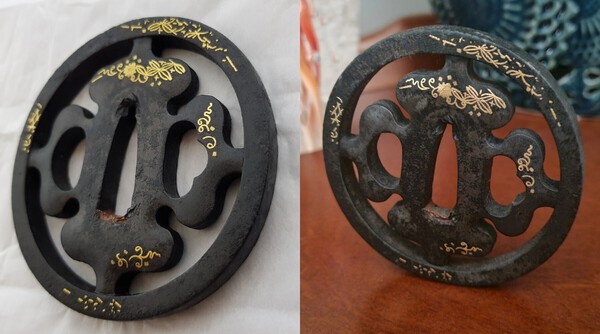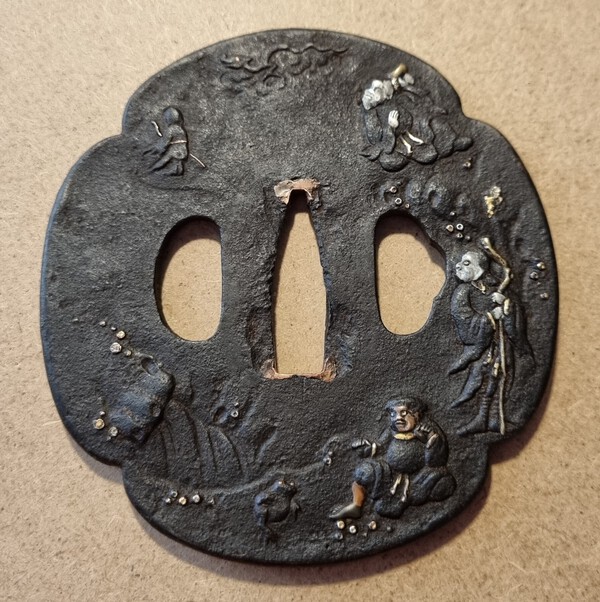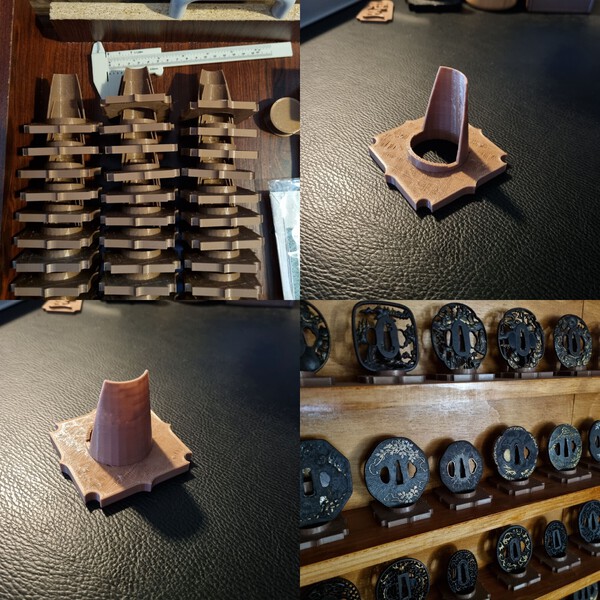-
Posts
642 -
Joined
-
Last visited
-
Days Won
3
Content Type
Profiles
Forums
Events
Store
Downloads
Gallery
Everything posted by Steves87
-
I thought it looked familiar! Dale is every bit the grandmaster when it comes to this stuff! Here is a screen shot of the likely similar original Tsuba style from Dale's linked thread (for ease of viewing)
-
This guard has likely been cut down from within a mimi-rim. I would bet @Spartancrest has an example of a non-cut down guard.
-
Yes this is true, there are a few techniques that go for a wrist strike (that i know about). We used to do full contact sparring with shinai (kenjutsu, not Kendo), and one trick was swapping the tsuba out for extra large Tsuba (3d printed) incase these moves were done. It worked, but the solid plastic Tsuba only lasted a couple of hits before it snapped on mis-judged strikes/blocks. The wrist hits generally were not heavy enough to break the guard, but they did stop the shinai.
-
There are quite a lot of thick guards out there, this one is not as thick as the example you have, but it is able to stand upright on the face of the mimi. I believe this represents a Mon, but I couldn't tell you which one, off the top of my head.
-
I agree with Jay, I have a feeling only steel is 3d printed at this point; however, wax can be 3d printed for casting brass (lost wax casting), so this is very possible in this case https://www.zeal3dprinting.com.au/brass-3d-printing/#:~:text=The lost-wax casting method,in the final product design.
-
On a slight bend of the topic, that first yoshiro mon Tsuba is the first I have seen where a mon has a (Kiri?) Stalk.
-
Thanks Geraint (and Chris), believe it or not, but that is actually still very helpful. It is good to know that the re-patination is basically un-aided and relatively speaking, quite fast... When you consider that this also happens in what I would call a "stored" state, it bodes well for other examples in a state of despair.
-
Great post Geraint, Can you please shed some light on the storage conditions you had this guard in? Maybe something like: (Almost) exact timeframe. In/out box. If out of box, mounted or display. If out of box (mounted or display), location in house... eg, near living/kitchen/bathroom/laundry rooms (for light/humidity/temps)... cupboard/drawer with approx frequency of opening. It would be good to get an indication of these also for preventative conservations sake.
-
-
Good one Dale! I think the finger pointing confirms that the most. Most depictions of Kanzan and Jittoku that I come across have both with the knotted hair, or one with knots and the other with straight hair.... I found it strange that one has a hat in this case. Here is a couple of Tsuba with two different hair depictions, one has both figures with knotted hair, and the other has both straight (possibly one is a hat).
-
Someone may know for sure. However, based on the smaller figure's hair style and the text scroll, I would say it is likely to be a Rin Nasei (Lin Hejing) theme. This is a Tsuba example of the theme.
-
Good memory George, I vaguely remember that thread. Whenever I refer to this guy from now on, I'll be using "Handaka (possibly Chinnan) Sennin".... Great to see Stevenk's posts again, too. He was the first guy to reach out to me on here.
-
Yep, you have convinced me, after some more searching I definitely agree Handaka (the bamboo cutter?)... it explains the cane too
-
Handaka Sennin it seems. I have read that Tekkai Sennin can also change into a dragon or a human figure though. I have this one with both Gamma Sennin, Tekkai Sennin, and Handaka Sennin, which shows the dragon form at the 12 o'clock.
-
Love it! Well done!
-
I quite like that, congratulations! The flow of the grain is very nice, and I think it may also be the first time I have seen samegawa ategane too!
-
Like Mauro says, who (really) knows? I try not to get caught up in exact dates, the important thing in my eye is the work which went into making something such as this, and then relating it to the costs and effort of someone making it in modern times (by traditional methods).... In any case, and like Okan believes, I feel that your example is more likely to be of Japanese origin because of the design elements (eg. fan, clove, shippo mon?), but I'm just guessing.
-
It looks like the hitsu ana is a modification with a shakudo fukerin bordering the ana. I have a similar example with an added hitsu-ana/shakudo fukerin.
-
The clear stands are optimal for sure. A while back you could get a transparent white filament for printing, but it wasn't transparent at all once printed. I'd love to have a perspex plate (with a small peg) so that the whole face of the Tsuba is unobstructed, and, if a mirror behind, the whole face of the reverse side would be unobstructed too. I have looked for something proprietary that would meet this want, but it seems there is nothing readily available, and id have to construct them myself, one by one.
-
Well, I am voting for the ultra leftside theory of "a new style of shingen" 😉
-
I really like the wood patterning on that, congratulations on your acquisition. I don't really know anything about cicada, but I came across this one yesterday. https://www.ebay.com...r=artemis&media=COPY
-
Basically the same design, nice thinking Jean! You achieved a very effective design naturally, in only 4 cuts!
-
Nice one Jean, stand damage really should not be an issue if both are stagnant. I'd really only worry about moisture absorption when holding iron, or materials that 'off-gas', otherwise most 'soft' materials should be ok?
-
Hi Justyn, I can understand your concern. I can confirm that I have now just checked three soft metal Tsuba (one with Nanako - a polished face - and a Chidori-ishime finish), and none show any signs of wear. One of these has been propped by the stand for at least three years, and I have been using the stands for nearly 7 years on most (or all) Tsuba construction materials. The contact surfaces of this stand are technically only small 4 areas (less than a millimetre each); two at the bottom on the mimi, and one either side of the Nakago-ana (within the seppa-dai). The plastic you use is dependent on what filament you personally prefer... I use PLA which can be scratched with a fingernail. I use this material in its print-extruded state with all sorts of bare-untreated-unpatinated metals and it has not caused any form of corrosion to date (including Chinese-made functional dojo katana blades). I guess one thing to consider, is how much movement your object will be making while in the stand; technically, the object should not be moving at all. I say technically because: in a previous profession I worked in for over 20 years, we did study the effects of vibrations (from wind/traffic/sounds etc) on buildings and the effect these vibrations had on the building (and the contents too, in some cases). High rise buildings move a lot through sway and wind induced vibrations, and buildings next to heavily traffic motorways are vibrated massive amounts via sound and heavy vehicle contact with the road. Potentially, the stands could mark a Tsuba that is propped by a plastic stand in these high movement cases, but even then, I would guess there is more chance of the stand being deformed first, and I'd say there is more chance of a timber stand causing damage to a Tsuba, before the plastic one does!
-
Hi everyone, I have been getting quite a few messages on instagram about the Tsuba stands I created and use. I have started to offer out the .stl file for people to make their own, and I thought it may be a good idea to share here too. They are a simple 3d printed design and can be printed very quickly, depending on the quality settings. The pictures show examples of the lowest quality setting (some minor disruptions on top of the base). If you have a 3d printer, or access to one, it is a good option for a stand that is very consistent when displayed on a shelf. https://www.dropbox....rmmh4nrt4lpz70k&dl=0















